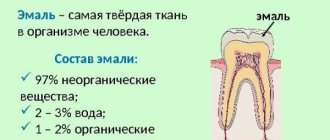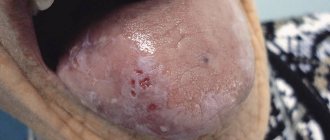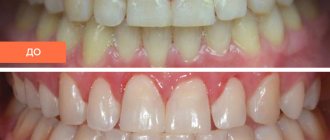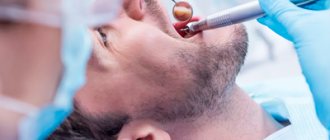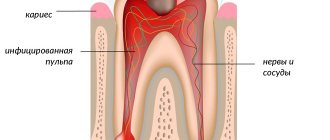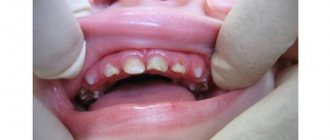Many adults, not to mention children, experience an overwhelming fear of treatment and tooth extraction. Local anesthesia is not indicated for everyone; general anesthesia is used infrequently. In cases of pathological fear, modern dentistry offers sedation - a new method of treating a patient who is half asleep. At the same time, he can respond to the dentist’s verbal commands and answer questions, which greatly facilitates the doctor’s work. The state of sedation does not mean deep sleep with the exclusion of external stimuli, as happens when general anesthesia is administered. Being in a much more comfortable and relaxed state, the patient easily endures a complex operation. There are not many medical organizations in the capital where treatment and tooth extraction under sedation have already been tested and are constantly being used. The VivaDent clinic is one of these. We invite Muscovites and guests of the capital to try the advanced technique and personally see the effectiveness of treating oral diseases with sedation.
Navigation
- When is sleep used?
- Types of sedation
- Methods of administering anesthetic
- Advantages and disadvantages
- Specifics of treatment for special children
- Sedation in our dentistry
What is sedation?
Sedation is a process of relaxation and anxiety relief. The word itself comes from the Latin “sedatio”, which translates as “calm”. In dentistry, various sedatives are used for these purposes, which are administered by inhalation or intravenously. Thus, it is customary to distinguish several types of such anesthesia:
- inhalation sedation: for this direction we use the inert gas xenon, which does not anesthetize, but relaxes before introducing the main anesthesia (usually local, that is, infiltration or conduction, which allows you to anesthetize the tissues of the oral cavity).
- intravenous sedation: sedatives are administered through a catheter directly into a vein. The patient becomes drowsy (sleeping or dozing),
- general anesthesia: drugs are administered intravenously (inhalation is also possible, but this type of anesthesia is not used in dentistry). The person goes into medicated sleep for several hours.
Is there any contraindications for sedation in dentistry for children using nitrous oxide?
There are only a few contraindications for performing ZAKS: age under three years, respiratory diseases, such as rhinitis and runny nose, as well as epilepsy. The fact is that nitrous oxide, even in small concentrations, increases intracranial pressure. This is absolutely safe for a healthy child, since the fluctuations are completely insignificant. But with epilepsy, when the regulation of intracranial pressure is already impaired, this can provoke an attack. That is, in case of epi-status, with a clearly defined epileptic diagnosis, nitrous oxide - oxygen sedation is not used. As for one-and-a-half-year-old, two-year-old and even three-year-old children who are not yet able to interact verbally with a doctor, in the case of serious tooth decay, for example with bottle caries, it is recommended to use anesthesia.
How is intravenous sedation different from general anesthesia?
The main difference is in the drugs used. As a consequence - in the duration of medicated sleep, the quality and effect of anesthesia, the severity of side effects and consequences, as well as in the subsequent rehabilitation of the patient.
- number of drugs: with intravenous sedation, only one drug is used, and it can be in different dosages (and, of course, is selected strictly individually based on the results of in-depth diagnostics). The patient will be in medicated sleep during the entire period of the operation, or in a relaxed state, half asleep. With general anesthesia, 2 or more drugs are used, including tranquilizers and narcotics, which puts a greater burden on the body,
- anesthetic and analgesic effects: during general anesthesia all receptors are “switched off”, during sedation - partially, which occurs due to a decrease in general sensitivity,
- consequences: after general anesthesia, side effects may appear within 2-3 days after surgery. This is not just dizziness and confusion, but also lethargy and even hallucinations. With sedation, there is no need for hospitalization or a long stay in the clinic - complete recovery occurs within 1-2 hours. All side effects are short-term and mild.
Does the use of sedation in dentistry help in the treatment of children with Down syndrome?
As for the treatment of special children, the indication for sedation for them is any long-term treatment that is accompanied by unpleasant sensations. However, in these complex cases, sedation alone is often not enough; sometimes it is necessary to use anesthesia. This applies to children with cerebral palsy, autism, and Down syndrome. Quite often, such diseases are accompanied by behavioral characteristics and the inability of the child to independently carry out basic hygiene procedures (including brushing teeth), as well as a weakened immune system, so the degree of tooth destruction in such children is extremely high, which is why treatment becomes quite traumatic and sometimes associated with a lot of unpleasant sensations. At the same time, verbal contact with these children is not always possible. That is why treatment of special needs children in the vast majority of cases is indicated under general anesthesia (anesthesia).
Which is better, sedation or general anesthesia?
Intravenous sedation is carried out using lighter and simpler drugs, so it is the more preferable method of pain relief when carrying out large-scale work. And not only in dentistry, but also in many other branches of medicine. Fewer side effects, including prolonged action (with general anesthesia, they can appear even within a year after treatment), less stress on the liver, kidneys, cardiovascular and nervous system.
In general, the advantages of intravenous sedation are as follows:
- you fall asleep - you don’t feel pain, you don’t see how treatment or surgical procedures are carried out, and what instruments the doctor uses (and all this causes extreme stress for those who are afraid of the dentist),
- all treatment is carried out at one time, which is especially important in case of multiple scattered caries or in case of total restoration of teeth on implants,
- the quality of treatment improves and the risk of postoperative complications decreases, since the doctor is not distracted by the patient’s emotions,
- It is possible to carry out treatment in patients who are not affected by classical “freezing” or have allergic reactions to the drugs used.
With us you will stop being afraid of dentists! Individual selection of drugs, the most modern equipment and certified doctors who professionally work with all types of anesthesia.
Enroll now
When is sleep used?
Innovative methods of combating oral diseases are impossible without the use of advanced pain relief technologies. The skill of an anesthesiologist is highly valued, and the state of sedation is no exception. Half-asleep does not at all mean a refusal of anesthetics: since the patient’s consciousness is not turned off, he feels pain the same way as an ordinary person, only while in a light half-sleep. When using sedation, the exact dosage is especially important: if too much is administered, the postoperative period will not be easy; if too little is administered, the patient will be in pain. Progressive anesthesia is successfully used for both adults and children, since it does not cause significant harm to the body, like traditional anesthesia. It does not “turn off” the patient completely, does not cause damage to the nervous system, and does not have a detrimental effect on the functioning of internal organs. In what cases is sedation necessary?
- Intense fear of the dental chair.
- Pathologies of the cardiovascular system.
- Hypertension, coronary disease, arrhythmia.
- Excessive psycho-emotional excitability.
- Complex implantation with the insertion of six or more pins.
- Carrying out operations related to bone grafting.
IMPORTANT! Despite the mild effect of sedation, the use of this method of pain relief has some contraindications. To avoid increased intracranial pressure, sedative anesthesia is not given to people with epilepsy and mental disorders. This technique is not recommended for patients suffering from asthma, tuberculosis and other diseases of the respiratory system. Sedation is not given to children under 3 years of age, as well as to pregnant women and young mothers who are breastfeeding.
How is treatment performed under intravenous sedation?
The essence of using intravenous sedation is that certain anesthetics are introduced into the body, which put the person into sleep. The drug itself and its dosage are selected based on the patient’s weight, health status, and the duration of the procedure. If necessary, the drug can be reintroduced during surgery.
A catheter is inserted into a vein in the arm through which the medication is administered. The catheter remains in place until the end of the entire treatment, as repeated administration of the drug may be required.
The operation is performed on an empty stomach: you cannot eat or drink for 6 hours before sedation. The procedure is not limited in time. The patient wakes up naturally within 20 minutes after the end of the drug and is under the supervision of specialists for a maximum of 1-2 hours who will monitor their health.
After treatment under sedation, it is strictly not recommended to drive, as concentration decreases. There are no more restrictions.
Removal and treatment of teeth under general anesthesia –
General anesthesia in dentistry can be inhalational or intravenous. For inhalation anesthesia in dentistry, its mask or nasopharyngeal variants are more often used - with nitrous oxide, xenon, isoflurane and sevoflurane (Sevorane). The disadvantages of nitrous oxide are an insufficient degree of pain relief and often the inability to achieve the surgical stage of anesthesia, as well as muscle relaxation of the patient. Anesthesia with xenon and sevoran has a good speed of entry and exit from anesthesia, a pronounced analgesic effect - in comparison with nitrous oxide.
Xenon is generally considered one of the best drugs for inhalation and intravenous anesthesia. Sevoran has a pleasant smell and after just one inhalation, patients fall asleep, and 15 minutes after the end of the gas supply, patients are already able to think logically and move without assistance. Anesthesia with xenon and sevoran requires modern anesthesia-respiratory equipment, and therefore the cost of such anesthesia is higher than when using nitrous oxide.
In adults, in addition to inhalation and intravenous anesthesia, intramuscular anesthesia is also possible. The drug Ketamine can be used for this. After an intramuscular injection, anesthesia occurs within 4–6 minutes and lasts up to 1 hour, and repeated administration of the drug is possible. However, it should be taken into account that general anesthesia for dental treatment has a large number of contraindications (we listed them at the beginning of the article).
Sedation combined with general anesthesia (in a child) –
Comments on the video - Initially, the child was given a syrup with sedative components so that the child would fully cooperate with the doctor. Sedation was then used (a combination of inhaled Sevoflurane with intravenous sedation) as preparation for nasotracheal intubation. The latter is the safest method of intubation - without the risk of damage to the airway and without the risk of aspiration. But this option makes sense only if long-term intervention is necessary.
Dental treatment under general anesthesia: price
For dental extraction and treatment under general anesthesia - the price in Moscow for 2021 will be very different in economy class clinics and mid-price clinics. See price range below.
- consultation with an anesthesiologist – 1000 rubles.
- inhalation anesthesia (Sevoran drug) - for 1 hour from 10,000 to 15,000 rubles.
- intravenous anesthesia – for 1 hour from 10,000 rubles. (the cost of anesthesia is calculated in proportion to the time the patient spends under anesthesia, based on the price for 1 hour).
Cost in the regions of Russia - the cost of anesthesia with Sevoran starts from 7,000 rubles for 1 hour.
Tooth extraction under general anesthesia: reviews
In most cases, tooth extraction under general anesthesia does not pose any significant danger to the patient due to the short intervention.
However, there are rare cases when tooth extraction exceeds 1.5 hours (and this is usually the maximum time of anesthesia in dentistry). Most often, this can happen when removing impacted wisdom teeth or when accidentally perforating the maxillary sinus when removing the upper lateral teeth. Tooth extraction under anesthesia is, among other things, more traumatic for tissues. After all, if the doctor is in a hurry during a complex extraction, and he needs to saw a tooth with a drill or cut out a section of bone tissue (that interferes with the extraction of a tooth or its fragment), then you don’t particularly pay attention to the overheating of the bone while working with the drill. And this will lead to definite inflammation of the socket of the extracted tooth. Therefore, it is optimal to carry out treatment and removal under local anesthesia or sedation, and not under general anesthesia.
Disadvantages of dental treatment under anesthesia: reviews
In children from 0 to 3 years old, and sometimes from 3 to 5 years old, sedation and general anesthesia are the only ways to sanitize the child’s oral cavity. Moreover, at this age, the most important thing is a good marginal fit of the fillings to the dental tissues, and the aesthetic component is only secondary. Therefore, small aesthetic sins are not fundamental. But when treating teeth in adults in the aesthetic zone (in the area of the front teeth), patients have quite high demands on aesthetics, which is quite difficult to achieve while saving time.
Also, saving time does not allow high-quality restoration of the lateral surfaces of the teeth (contact points in the interdental spaces), or the correct formation of the chewing surface with all the cusps and fissures. It is also impossible to achieve good isolation of the tooth from saliva, because... the use of a rubber dam in this case is impossible, and the quality of composite fillings is simply affected by even the patient’s wet breath. Therefore, treating teeth under anesthesia (no matter how they tell you that the quality will not suffer) is only worth it in the most extreme cases. Because the quality will suffer.
In addition, most dental diseases (deep caries, pulpitis and periodontitis) are always treated in several visits, and the duration of each visit can sometimes exceed 1 hour. Under anesthesia, when you need to completely cure one or several teeth in just 1 hour, mechanical treatment and root canal filling cannot a priori be carried out ideally. According to statistics, root canals, even under ideal conditions, are filled poorly in 60-70% of cases.
Complications of root canal treatment –
- insufficient filling of root canals to the apex of the tooth root,
- insufficient obturation of root canals with filling substances,
- breakage of an instrument in the root canal,
- perforation of the tooth root,
- crack or fracture of a tooth root.
All this will definitely lead to the development of inflammation at the apex of the tooth root and the need for retreatment of the teeth or their removal. As a result of such treatment, patients often receive a not very beautiful filling, food getting stuck in the interdental space, the development of a cyst or the appearance of a fistula with pus (in the treatment of pulpitis or periodontitis). Read more about complications after poor-quality root canal treatment in the article: “Complications after treatment of pulpitis”
How will you feel?
Nothing, because sedation relieves all unpleasant sensations. At the same time, it can be superficial - you will be in a state of half-asleep or half-asleep (answering doctors’ questions, periodically falling asleep, but remaining in a relaxed state), or complete, when you will be sleeping throughout the entire time the operation lasts . Here the choice is yours. But in both cases you will not feel anything. The maximum is the “moving” of the instruments in the oral cavity, because you understand that the doctor is doing some kind of work.
Comfortable treatment without pain! We carry out thorough diagnostics, select medications and dosages strictly individually. It's safe here!
Enroll now
Sedation in our dentistry
The VivaDent clinic became one of the first medical institutions in the capital where dental treatment under sedation began to be widely used. The method has proven itself in practice in solving the most complex problems. It is used in surgery, implantology, orthodontics. Patients share that the procedure for removal or prosthetics is much easier, and recovery from the state of sedation takes no more than half an hour. We recommend this method of pain relief to many visitors. Of course, a thorough examination of the entire body must first be carried out, which tests will help with. Each branch has its own laboratory, so you can get the information your doctor needs at your first appointment. An undoubted advantage of sedation is the ability to get rid of the disease in one visit. We can explain the choice of Muscovites - more and more visitors are choosing this particular option for pain relief.
- A formal contract is concluded with each client.
- Before treatment, the method of sedative anesthesia is discussed.
- The method of administration of the anesthetic drug is agreed upon.
- The price of sedation is 7–9% lower than in other Moscow clinics.
- We will provide quality treatment without pain and discomfort.
- All types of services provided are guaranteed.
Immersing a person in a relaxed state with average muscle tone is an ideal option for a dentist’s work. A patient who responds to verbal requests, but does not feel pain, tolerates surgery well and easily emerges from the half-asleep state. Therefore, sedation has become very popular among visitors to our clinic. If you are interested in dental treatment, prosthetics, implantation using this method of anesthesia, call, consultants will be happy to answer your questions. Sedation has become a real lifesaver for adult patients and parents bringing small children to the doctor. Dental procedures will become not only painless, but also pleasant if you use immersion in a state of light sleep. Our doctors are confident: sedation is the technology of the future. Sign up, come and see for yourself!
Will it hurt during and after treatment?
No, there won't be any pain either. 1-2 hours after treatment, when the anesthesia wears off, tolerable pain may occur. It is associated exclusively with tissue injury. The doctor will prescribe painkillers for you: whether to take them or not is up to you to decide, based on your own condition. More than half of our patients after dental implantation take painkillers only for the sake of prevention - so that the pain does not overtake them in the middle of the night while sleeping, about 30% do not take them at all, and the rest do not take them as prescribed, because there is slight discomfort.
Do I need to prepare my child for sedation?
In principle, no. You should not overeat before the procedure. It is better to refrain from strong emotions the day before.
If in doubt and want to be on the safe side, you should take a general blood test and do an echocardiogram. You can show the doctor your medical card or tell in detail about past or chronic illnesses.
Is it worth telling the baby about the upcoming treatment? Here each parent decides for himself.
Some experts advise not to tell anything, because they themselves will tune their patient to the desired wavelength. Some children are so anxious that they don’t trust anyone except their dad and mom. Then it’s worth informing in advance what will happen in the doctor’s office. You can promise a prize to the bravest, and when it's all over, go to the toy store.
What if something goes wrong? Is this really safe?
Yes, it is completely safe: the administration of the anesthetic, as well as monitoring the patient’s condition, is carried out by professional and licensed anesthesiologists. The participation of professional anesthesiologists in the operation who monitor the patient’s condition allows the implant surgeon or maxillofacial surgeon at our clinic to fully concentrate on the operation. Constant monitoring of all vital indicators of the patient’s health status is mandatory.
In addition, there is an ambulance station in close proximity (up to 1 km) from each clinic. And this is an additional guarantee of your safety, because in case of complications, every second will count.
“Like you, we are sincerely interested in safe treatment and high-quality restoration of your health, so we make every effort to provide comfortable treatment: we focus on diagnosis, the correct selection of medications, and monitoring the condition during surgery.”
Namdakov Nikolay Vladimirovich maxillofacial surgeon, implantologist, orthopedist, work experience over 17 years make an appointment
Are there alternative sedation techniques?
Yes, they exist, and this is, first of all, hypnosis. But as for children, they are, in principle, very poorly introduced into such states. Due to physiological characteristics, children cannot be put into true Ericksonian hypnosis. But if you wish, you can achieve a cataleptic state, a state of deep immersion in the topic. However, this is the prerogative of psychologists; for dental treatment this method is not very effective. With the help of nitrous oxide, the child is brought into a state where he is completely relaxed, but at the same time he has a sort of waxy elasticity in his body, and an average tone is established. This is the most suitable condition for dental intervention.
Make an appointment
right now!
Snitkovsky Arkady Alexandrovich
Therapist, Orthopedist
What do patients say about treatment under sedation?
Most of our patients sleep during surgery and wake up after the doctor has finished treatment. Many people note that they sleep well during this time. If they remain conscious (lighter sedatives are used), then they do not feel pain, but there is a feeling of a slight “crawling” in the mouth from the knowledge that the doctor is removing/treating teeth or implanting implants.
Svetlana Yurievna
“They sat me at a table, put me on an IV, then transferred me to a chair and I don’t remember anything else. Before the operation, the doctor noted that he would look at my condition and see how much medication I would need. To be honest, this scared me. Because I thought that at some point the sedative would end, it would hurt and I would feel it. But nothing like that happened, I turned my head - they put additional medicine in my IV, and everything ended well. I am immensely happy!”
- treatment WITHOUT FEAR and pain
- guaranteed safety
- minimal health risks
- with condition monitoring and professional supervision
watch a video with the patient
What is sedation and how does it affect a child?
This is a way to remove the psychological barrier that a child involuntarily appears when he sees a doctor. The method relieves nervous tension and relaxes. Calm means ready for treatment.
The most common choice for children is oxygen sedation with nitrous oxide. To be clear, this is akin to laughing gas. Only such a gas will not cheer you up, but will calm you down and put you into a state of drowsiness.
Your baby will be conscious, he will not fall asleep, you can and should talk to him during treatment, he will just be slightly inhibited. No reflexes are suppressed, unlike anesthesia.
How to prepare for treatment
To ensure that sedation does not have any negative effects on the patient’s body, a thorough diagnosis of the health status before it is necessary - it will allow you to exclude possible contraindications, choose medications, and also find out what difficulties may arise during medicated sleep.
Tests and examinations before treatment under sedation
Before treatment or dental restoration under anesthesia, you will need to take a number of tests and undergo some examinations. You can take tests directly in our clinics completely free of charge: they are included in all types of dental implantation.
- general and biochemical blood test (AST, ALT, urea, creatinine, total protein, glucose, electrolytes), valid for 14 days,
- blood test for HIV, hepatitis C and B, syphilis, blood group and Rh factor, valid for 3 months,
- hemostasiogram or coagulogram (blood test), valid for 1 month.
All of the above tests are performed directly in our clinics completely free of charge. It is also additionally necessary to provide the results of the following examinations:
- ECG (electrocardiogram),
- Chest x-ray or fluorography – research results for the last 6 months are accepted: images or a specialist’s opinion (description of the images),
- For patients over 50 years of age, consult a general practitioner or cardiologist.
In a number of laboratories, these tests can be performed in a comprehensive manner: medical companies are developing special profiles called “hospital” profiles, in particular “for hospitalization in a surgical hospital.”
Lifestyle before treatment under sedation
- the operation is carried out without signs of acute respiratory viral infections and other infections. If you feel sick or become ill, be sure to notify your personal manager to reschedule your surgery,
- food: on the day before surgery, a light breakfast is allowed: dry toast, tea or weak coffee without milk. If the operation is in the morning, then you need to limit yourself to dinner only,
Important! Before surgery, under sedation, you cannot eat for 6 hours!
- drinks: stop drinking liquids 2 hours before surgery,
- alcohol: prohibited 2-3 days before surgery,
- taking medications: orally – no later than 2 hours before surgery,
- women are advised not to use cosmetics and must also remove all coating from their nails,
- After the operation, we do not recommend driving, so you must come to the clinic by taxi/public transport or ask someone you know to bring you.
Follow the link to study a detailed reminder about preparing for implantation.
Sedation is not anesthesia
Anesthesia is used in pediatric dentistry. But this requires serious reasons, thorough preparation and follow-up. In some cases, dentists issue special referrals for treatment under anesthesia. Not every clinic can provide such therapy.
Sedation cannot be called anesthesia either. It does not block pain, so the anesthetic injection is not canceled. But the calmed baby won’t even notice him.
The procedure is very common and loved by dentists, as well as parents, who have already tried it and are convinced that there are practically no risks. We leave the “practically” remark for extreme cases, because all children are different, and in any case an individual approach is needed.
Are there any disadvantages to sedation?
Naturally, dental treatment or implantation under general anesthesia has certain disadvantages. In particular, the need for rehabilitation after the administration of the drug and a fairly large list of contraindications. However, our clinic conducts a thorough diagnosis of the body’s condition before using any anesthetics. If the doctor identifies certain risks, you will be denied sedation and will not take any risks. In addition, by working with professional anesthesiologists, any unpleasant consequences are reduced to a minimum.
Types of sedation
Experts distinguish the following types of sedation:
- superficial
sedation is caused by maximum relaxation of the body and suppression of fear with complete preservation of all body functions and the ability to verbally communicate if necessary; - deep
sedation is characterized by a state close to general anesthesia, that is, consciousness is completely turned off and basic reflexes are somewhat suppressed.
In dentistry, superficial sedation is actively used, which is carried out by introducing certain doses of drugs into the body by injection or orally. The mask method of suppressing consciousness to a state of euphoria is provided by inhaling nitrous oxide vapor. These drugs have a moderate inhibitory effect on the central nervous system and are considered the most optimal and safe in pain relief during the treatment process.
Anesthesia and deep sedation are carried out only in specialized dental surgery departments with experienced anesthesiologists, all the necessary equipment (ventilator) and medications for emergency care (pressure drop, cardiac arrest). In this case, the patient undergoes mandatory training.


